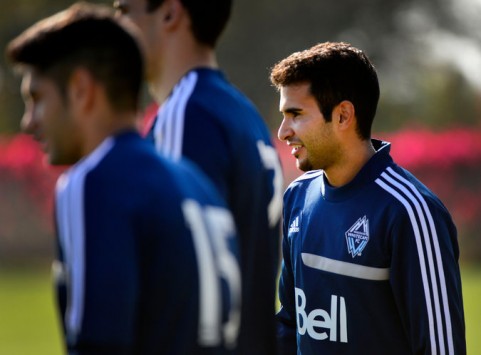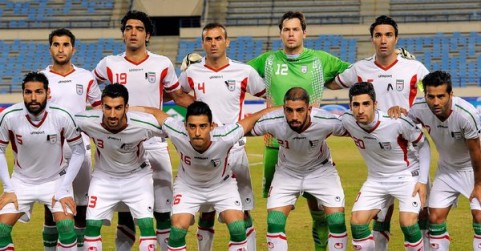
Nytimes - Steven Beitashour was 11 during the 1998 World Cup in France, where the United States, the country of his birth, faced Iran, where his parents were born.
The family gathered at home in San Jose to watch as Iran won, 2-1, in a match that drew extraordinary interest because of the political estrangement between the countries.
Asked whom he rooted for, Beitashour (pronounced BAIT-uh-sure) smiled and answered diplomatically. “I was rooting for a good game,” he said.
Even then, Beitashour wanted more than to watch the World Cup on television. Ronaldo, a Brazilian star, was his hero, and he dreamed of wearing the colors of Brazil with a boy’s enthusiasm and naïveté about borders and passports and international politics.
The moment for Beitashour, 27, appears to have arrived. Twice in recent years, he was called in to train with the United States national team, but he did not participate in a match. His international eligibility remained fluid. Last October, Iran gave him a chance to play at right back and Beitashour accepted, his chances of making the American team having receded.

He is expected to be in Brazil for the World Cup in June, when Iran will face Nigeria, Argentina, and Bosnia and Herzegovina in group play.
For the next World Cup, in 2018, Beitashour will be 31. This is probably his one chance to play at soccer’s highest level, in the world’s biggest sporting event. He said he could not pass it up.
“If you had a chance to play potentially for a World Cup team, would you say no?” Beitashour said last weekend when his club team, the Vancouver Whitecaps, traveled to Southern California to face Chivas USA in Major League Soccer. “Any country, if that was always your dream to play at the international stage, what’s bigger than the World Cup? Nothing.”
Given the fraught political history between the United States and Iran, including the hostage-taking at the United States embassy in Tehran after the 1979 Islamic revolution and the contentious issue of Iran’s potential nuclear capability, Beitashour’s decision fostered some debate among fans online. At least one accused him of “selling his soul” for the chance to play in a World Cup.
At the top levels of American soccer, there appears to be no begrudging of Beitashour’s decision. Sunil Gulati, the president of the United States Soccer Federation, noted that in an increasingly globalized world, players will continue to make pragmatic decisions based on their best interests. Gulati said he was under no illusion that Jermaine Jones, a midfielder born in Germany to an American father and a German mother, would be playing for the United States if he had a realistic chance of playing for the German national team. Carlos Bocanegra, a former captain of the American team, mentioned Giuseppe Rossi, a forward born in New Jersey to Italian-American parents. Rossi chose to play for Italy, the winner of four World Cups.
Of Beitashour, Bocanegra said: “If you have a chance to play in the World Cup, that’s pretty hard to turn down. Everybody has to make up their own mind. If he feels that’s something he wants to do, and he gets to play in a World Cup, good for him. You can’t tell somebody what to feel.”
While the United States does not have diplomatic relations with Iran, the countries have found common ground in sports. Last September, Iran and the United States lobbied successfully to have wrestling restored to the Summer Olympics.
Iranian and American soccer officials have a cordial relationship. The Iranian national team has an American assistant — until recently, it had two — and the countries recently discussed playing an exhibition game in the United States and establishing a training camp for Iran before the World Cup. The match fell through for reasons having to do with preparation strategy and logistics, but it had the public blessing of the State Department.
“We’ve always said we were open to direct negotiations and talks with the Iranians, so where better place than on the soccer field, right?” Marie Harf, a State Department spokeswoman, said last October at a news briefing, days after President Obama spoke by phone with the Iranian president, Hassan Rouhani, in the first conversation between the countries’ leaders since 1979.
Twice as a young boy, Beitashour visited relatives in Tehran, Iran’s capital. He understands Farsi and said he could speak it adequately. At home, his family observed the traditions of renewal during the Iranian New Year each spring, setting the table with goldfish and sweets and the Quran; tossing sprouts of wheat or barley into running water; jumping over fire while singing a song of purification and rebirth.
His soccer skills developed amid two cultures: the structured American system and improvised weekend pickup games against older Iranian men in local parks. His father, Edward Beitashour, came to the United States as a student in the early 1960s, long before the Islamic revolution, and played soccer at San Francisco State before becoming an electrical engineer. Even now, in retirement, Edward Beitashour watches all of his son’s games and sends emails with critiques of his performance.
“He’ll watch this game three or four times on his computer,” Tony Beitashour, 29, Steven’s older brother, said of their father while Vancouver played Chivas USA at StubHub Center in Carson, Calif. “He’s Steven’s biggest fan and critic.”
The soccer cultures of the United States and Iran intersected memorably on June 21, 1998, for a World Cup match in Lyon, France. Before the game, American and Iranian players stood for photographs with their arms around one another’s shoulders. They shook hands and exchanged gifts. Afterward, several exchanged jerseys.
“We came here to show everyone there is no problems between people of two countries,” Jalal Talebi, Iran’s coach at the time, said before the match. Talebi lived (and still lives) in the Bay Area, where his wife owned a vegetarian restaurant and a skin care business.
Beitashour’s refusal to say which team he rooted for in that dramatic game was not coy evasiveness but a sign of his proud and inextricable ties to both the United States and Iran, said a close friend since high school, Mahan Bozorginia, 27, a civil engineer in San Francisco.
“Your background, your culture is where your parents are from, from Iran,” Bozorginia said. “At the same time, you didn’t grow up in that country. You grew up here. You go to school with Americans. You grow up speaking English first. You feel a tie to Iran, but you feel that same exact tie to the United States. You support both countries, embrace both sides. You know both sets of people. When someone asks, ‘Take your pick,’ it’s like, ‘How could I?’ ”
For Beitashour, it seemed as if his chance to represent either country in a World Cup might never come. He grew up in San Jose, built a small makeshift field in his backyard, was a ball boy for the San Jose Clash (now the Earthquakes), became a high school star and won a scholarship to San Diego State. But he never played on any youth national teams, and neither the United States nor Iran showed interest in him before the 2010 World Cup in South Africa.
That began to change after Beitashour, playing for his hometown Earthquakes, led the team in assists in 2011 and became an M.L.S. all-star in 2012, providing reliability as a one-on-one defender and the ability to go forward and serve the ball from the flank.
“He would have been just as proud to wear the red, white and blue as the red, white and green” of Iran, Bozorginia said. “Whoever was going to give him the opportunity to play at the level he wants to play, that’s where he was going to go.”
Coach Jurgen Klinsmann called in Beitashour to train with the United States national team in August 2012 before a friendly in Mexico, but Beitashour did not play as the Americans won their first game at Estadio Azteca. Another call-up to a training camp, in January 2013, ended prematurely for Beitashour because of the lingering effects of a sports hernia that required a second operation.
Once Beitashour resumed playing for the Earthquakes, he said that Klinsmann told him, “Good to see you back” and wished him well. But there was no further contact, Beitashour said. Brad Evans emerged as a reliable right back for the Americans, and Geoff Cameron was also dependable. By last October, Beitashour felt the window beginning close on his World Cup chances.
At the same time, Carlos Queiroz, the Portuguese coach of Iran’s national team, continued his search for players of Iranian heritage who played in leagues outside the country and possessed more rigorous professionalism and more sophisticated training habits.
These players included the star forward Reza Ghoochannejhad (known as Gucci) of Charlton Athletic in England’s second division, and wing Ashkan Dejagah of Fulham in the Premier League. When Iran offered Beitashour a chance to play last October in a qualifying match for the 2015 Asian Cup, he accepted.
He did not think his chances of playing for the United States were over, necessarily, but he had not heard from Klinsmann in months. “I needed to start playing,” Beitashour said. “You’ve got to make a decision. That was pretty much it.”

His mother, Pari, happened to be in Tehran at the time and met him at the airport at 4 a.m. A flock of reporters also greeted him. As he warmed up before the match, some in the crowd at Azadi Stadium chanted in English, “Beitashour, welcome to Iran.” And before he entered late in the match, they called out in Farsi, “Put Beitashour in.”
At its most resonant, international sport engages because it distinguishes between governments and people. It was his hope, Beitashour said, that his experience could help to further deflate corrosive stereotypes of Iranians as fanatics and the United States as the Great Satan.
Despite Iran’s often being portrayed as strident, Beitashour, who has joined Iran for four matches, said: “It was so welcoming over there. They just love their national team and they just want you to win.”
Yet certain strictures of Iran’s Islamic culture also apply to its national sport. While Iran defeated Thailand, 2-1, in that October match, Pari Beitashour had to watch her son on television because women cannot attend games in the national stadium. (Some are known to sneak in disguised as men.)
International sanctions against Iran, such as frozen accounts in foreign banks, have also affected Iran’s World Cup preparations, according to two American assistants. Two training camps were canceled last fall for lack of funds, said Omid Namazi, an Iranian-American assistant, who added that he recently left the team, in part, because he had not been paid in five months.
Still, qualifying for the World Cup, along with the election as president of Rouhani, who is considered a relatively moderate cleric, seems to have brought some hopefulness that Iran may be able to reduce its international isolation, said Dan Gaspar, a Connecticut native who works as Iran’s goalkeeper coach.
In the unlikely event that Iran faces the United States in the World Cup, the match could come in the quarterfinals. More urgently, in group play Beitashour may find himself facing Argentina’s Lionel Messi, widely considered the world’s best player.
“As a friend, I’m like, ‘I’ve got your back; you can do it,’ ” said Bozorginia, who wore a Beitashour replica jersey at the Vancouver-Chivas USA match. “As a fan, I’m like: ‘You might want to back off a little, make him pass the ball. Don’t end up on “SportsCenter.” ’ ”